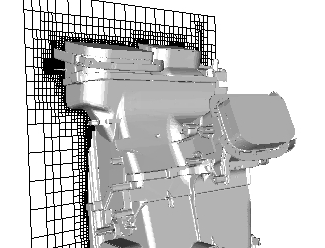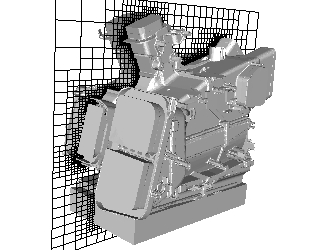 |
case study | automotive |
Behr chooses Harpoon to aid in-car passenger comfort by Lisa Cooper Turning up the car’s heating or switching on the air-con are such common everyday tasks that drivers take them for granted. But hidden behind those simple-looking vent flaps are some pretty complex geometries Heating, ventilation and air-conditioning (HVAC) modules and ducting systems pose a challenge for design engineers. Consisting of complex geometries with several inlets and multiple outlets, air is most commonly controlled with one blower, with separate ducts to vents at floor and face-level and below the windscreen. Further complicating the picture are severe packaging constraints, with ducts having to be fitted around the steering column, structural framework and airbags. Based in Stuttgart, Germany, Behr Group is one of the world’s leading manufacturers and suppliers of automotive air conditioning and engine cooling systems, with an annual turnover of around 3.2 billion euros. Behr employs close to 20,000 staff at 18 development locations, 30 production sites and 13 joint ventures worldwide. Behr has developed an accurate methodology for predicting HVAC module air and temperature distributions, which can be built into the early stages of design. However, mesh generation for the HVAC module of a car is an awkward and time-consuming business. CAD models describing the module must be collected, cleaned and matched together before meshes can be generated. But with the aid of Harpoon, the extreme mesher developed by Manchester, UK-based Sharc, Behr has been able not only to make savings in time and efficiency, but also to improve the quality of its meshes. The company began using Harpoon less than a year ago and now uses the software for the meshing of HVAC unit housings, including flaps, and for all kinds of air ducts and channels between the HVAC unit and the passenger cabin. Behr has also experimented with complete cabin simulations in Harpoon. And in addition to the HVAC field, Behr has successfully applied Harpoon in engine cooling applications, including for tanks of charge air coolers and other heat exchangers and for generating under-hood meshes. “In almost all cases, we are faster – sometimes much faster – with Harpoon compared to the process we used previously, without any compromise in the mesh quality,” says Dr Thomas Wetzel, Manager of Method Development at Behr. Although Behr had used octree volume meshers before, it had been on the lookout for some time for a tool that could build predominantly hexahedral meshes. These meshes tend to be time-consuming to create, but Harpoon is able to generate large and complex meshes in minutes. Wetzel recalls, “We asked for a demo licence, started one day later and were excited by it from the very beginning”. For HVAC processes, Behr begins with CAD geometry, which must be CFD-compatible, but not necessarily entirely ‘clean’, in the CAD system and exports an STL or T-Grid surface format from there into Harpoon. Other processes, such as hole-filling or preparation of families take place directly in Harpoon. After meshing, models are then solved in STAR from CD-adapco. As well as speeding up the mesh generation process, since introducing Harpoon Behr has also made substantial savings in calculation times. “Previously we sometimes needed several refinement or adjustment loops until a model was finally converging. Because the Harpoon mesh quality is so much better, that has been reduced drastically,” says Wetzel. Behr plans to roll out Harpoon to all the company’s CFD locations, which include France, India and the US as well as Germany, and to expand its usage of the software. “We want to use Harpoon in fully automatic model set up processes between CAD and the running model,” says Wetzel, which, he explains, will help to quickly and reliably reproduce meshes for design variants. Thanks to Harpoon’s speed, mesh quality and ease of use, Behr is confident that rolling the software out across global locations and expanding its use within the company will be straightforward. Wetzel rates the support he and his team have received from Sharc as “simply excellent”. He continues, “They are competent in their field, understand our applications, are truly interested in making Harpoon a benefit for us and, above all, we really like working with them personally – it’s a pleasure!”
|
Example of the complex geometry used by Behr
|


